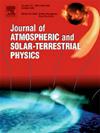Rayleigh–Bénard convective motion of stratified fluids in the Earth’s troposphere
IF 1.8
4区 地球科学
Q3 GEOCHEMISTRY & GEOPHYSICS
Journal of Atmospheric and Solar-Terrestrial Physics
Pub Date : 2025-01-25
DOI:10.1016/j.jastp.2025.106442
引用次数: 0
Abstract
Recently, Kaladze and Misra (2024) showed that the tropospheric stratified fluid flows may be unstable by the effects of the negative temperature gradient and the temperature-dependent density inhomogeneity arising from the thermal expansion. They also predicted that the modification in the Brunt–Väisälä frequency by the density inhomogeneity can lead to Rayleigh–Bénard convective instability in the tropospheric unbounded layers. The purpose of the present work is to revisit the Rayleigh–Bénard convective instability in more detail by considering both unbounded and bounded tropospheric layers. Starting from a set of fluid equations for incompressible neutral fluids with temperature gradients and using the Boussinesq approximation, we derive the general dispersion relations for Rayleigh–Bénard convective waves in unbounded and bounded tropospheric domains and analyze them with some particular cases both analytically and numerically. We show that the conditions for instability in these two cases significantly differ. Furthermore, we obtain and analyze the critical values of the Raleigh numbers and the expressions for the instability growth rates of thermal waves in the two cases. In the case of the bounded region, we also derive the necessary boundary conditions and note that the vertical wave number is quantified, and the corresponding eigenvalue problem is well-set.
地球对流层中分层流体的瑞利-巴萨姆德对流运动
最近,Kaladze和Misra(2024)发现对流层分层流体流动可能受到负温度梯度和热膨胀引起的温度相关密度不均匀性的影响而不稳定。他们还预测,密度不均匀性对Brunt-Väisälä频率的改变会导致对流层无界层的瑞利-巴萨纳德对流不稳定。本研究的目的是通过考虑无界对流层和有界对流层,更详细地重新审视瑞利-巴萨纳德对流不稳定性。本文从具有温度梯度的不可压缩中性流体的一组流体方程出发,利用Boussinesq近似,导出了对流层无界域和有界域的rayleigh - bassanard对流波的一般色散关系,并结合一些特殊情况对其进行了解析和数值分析。我们表明,在这两种情况下,不稳定的条件明显不同。此外,我们得到并分析了两种情况下的罗利数的临界值和热波不稳定增长率的表达式。在有界区域的情况下,我们也推导了必要的边界条件,并注意到垂直波数是量化的,相应的特征值问题是良集的。
本文章由计算机程序翻译,如有差异,请以英文原文为准。
求助全文
约1分钟内获得全文
求助全文
来源期刊

Journal of Atmospheric and Solar-Terrestrial Physics
地学-地球化学与地球物理
CiteScore
4.10
自引率
5.30%
发文量
95
审稿时长
6 months
期刊介绍:
The Journal of Atmospheric and Solar-Terrestrial Physics (JASTP) is an international journal concerned with the inter-disciplinary science of the Earth''s atmospheric and space environment, especially the highly varied and highly variable physical phenomena that occur in this natural laboratory and the processes that couple them.
The journal covers the physical processes operating in the troposphere, stratosphere, mesosphere, thermosphere, ionosphere, magnetosphere, the Sun, interplanetary medium, and heliosphere. Phenomena occurring in other "spheres", solar influences on climate, and supporting laboratory measurements are also considered. The journal deals especially with the coupling between the different regions.
Solar flares, coronal mass ejections, and other energetic events on the Sun create interesting and important perturbations in the near-Earth space environment. The physics of such "space weather" is central to the Journal of Atmospheric and Solar-Terrestrial Physics and the journal welcomes papers that lead in the direction of a predictive understanding of the coupled system. Regarding the upper atmosphere, the subjects of aeronomy, geomagnetism and geoelectricity, auroral phenomena, radio wave propagation, and plasma instabilities, are examples within the broad field of solar-terrestrial physics which emphasise the energy exchange between the solar wind, the magnetospheric and ionospheric plasmas, and the neutral gas. In the lower atmosphere, topics covered range from mesoscale to global scale dynamics, to atmospheric electricity, lightning and its effects, and to anthropogenic changes.
 求助内容:
求助内容: 应助结果提醒方式:
应助结果提醒方式:


